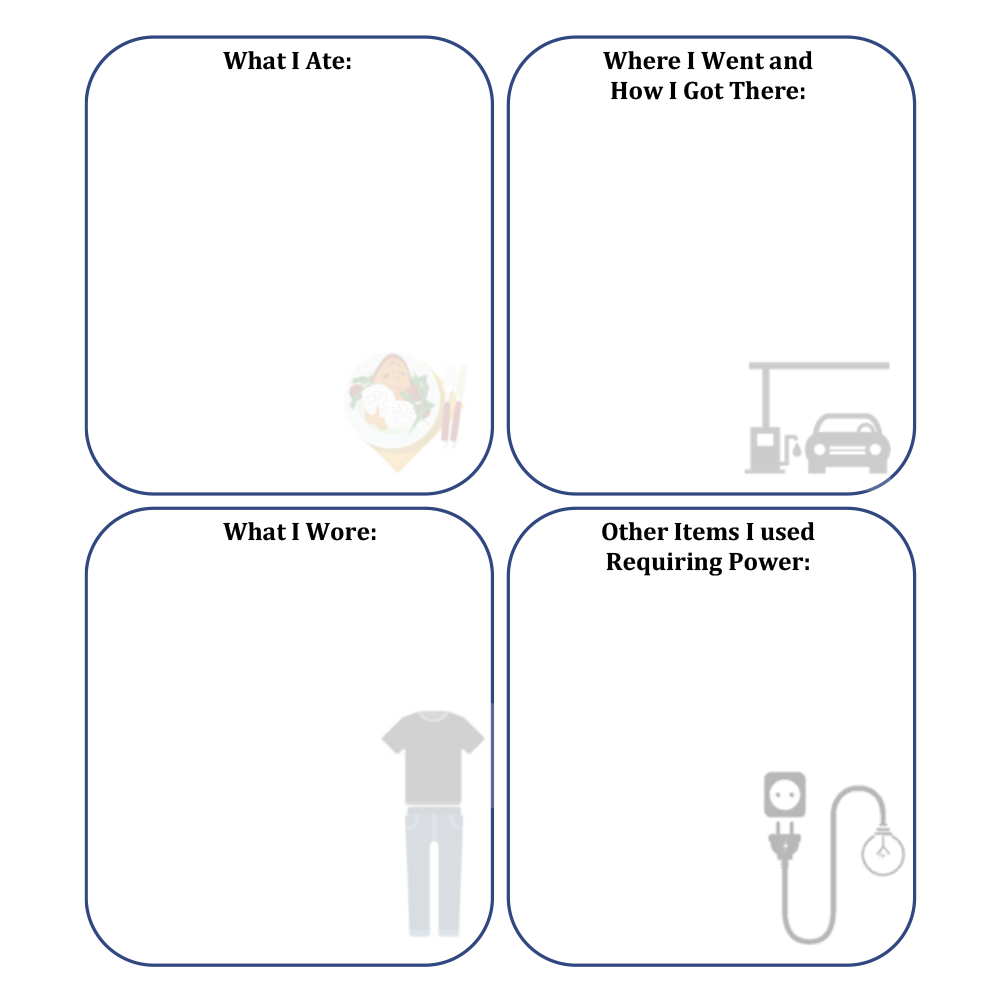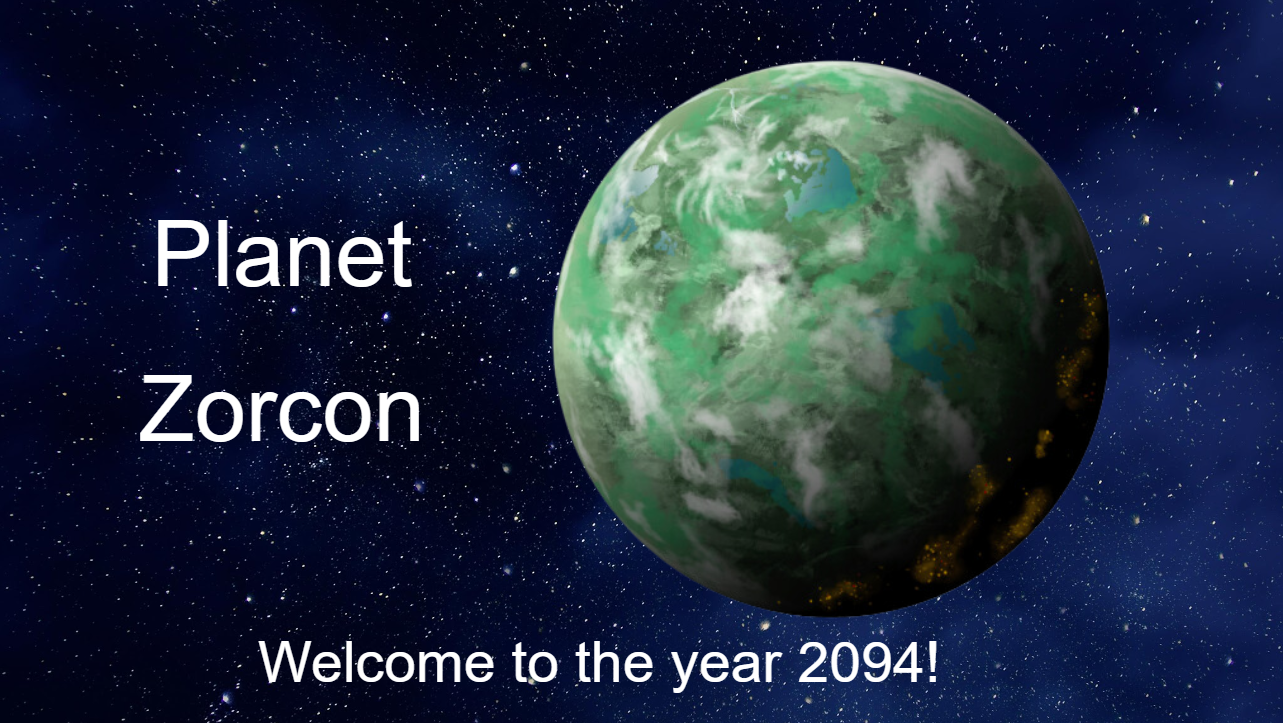Planet Zorcon (Grades 6-8)
Students explore the connection between individual behavior and resource use, learn the difference between renewable and nonrenewable resources, and identify careers related to natural resource management by playing an active, futuristic simulation game in which teams have to collect limited resources from "Planet Zorcon."

Background
Lesson Activities
Recommended Companion Resources
Credits
Author
Debra Spielmaker, Geoff Smith, and Andrea Gardner | Utah Agriculture in the Classroom and National Center for Agricultural Literacy (NCAL)
Sources
The original lesson plan was adapted from What will tomorrow bring? from the International Office of Water Education, Utah State University. The lesson was updated in 2020 by the National Center for Agricultural Literacy.
Standards
Texas Content Area Standards
-
Career and College Exploration: 127.2.d.1
The student takes one or more career interest surveys, aptitude tests, or career assessments and explores various college and career options. The student is expected to:
- Career and College Exploration: 127.2.d.1.C: identify various career opportunities within one or more career clusters.
-
Principles of Agriculture, Food, and Natural Resources: 130.2.c.1
The student demonstrates professional standards/employability skills as required by business and industry. The student is expected to:
- Principles of Agriculture, Food, and Natural Resources: 130.2.c.1.A: identify career development, education, and entrepreneurship opportunities in the field of agriculture, food, and natural resources.
- Principles of Agriculture, Food, and Natural Resources: 130.2.c.1.B: apply competencies related to resources, information, interpersonal skills, problem solving, critical thinking, and systems of operation in agriculture, food, and natural resources.
- Principles of Agriculture, Food, and Natural Resources: 130.2.c.1.C: demonstrate knowledge of personal and occupational safety, environmental regulations, and first-aid policy in the workplace.
- Principles of Agriculture, Food, and Natural Resources: 130.2.c.1.D: analyze employers' expectations such as appropriate work habits, ethical conduct, legal responsibilities, and good citizenship skills.
- Principles of Agriculture, Food, and Natural Resources: 130.2.c.1.E: identify careers in agriculture, food, and natural resources with required aptitudes in science, technology, engineering, mathematics, language arts, and social studies.
-
Principles of Agriculture, Food, and Natural Resources: 130.2.c.4
The student explains the historical, current, and future significance of the agriculture, food, and natural resources industry. The student is expected to:
- Principles of Agriculture, Food, and Natural Resources: 130.2.c.4.B: analyze the scope of agriculture, food, and natural resources and its effect upon society.
- Principles of Agriculture, Food, and Natural Resources: 130.2.c.4.C: evaluate significant historical and current agriculture, food, and natural resources developments.
- Principles of Agriculture, Food, and Natural Resources: 130.2.c.4.E: describe how emerging technologies and globalization impacts agriculture, food, and natural resources.
- Principles of Agriculture, Food, and Natural Resources: 130.2.c.4.F: compare and contrast issues impacting agriculture, food, and natural resources such as biotechnology, employment, safety, environment, and animal welfare issues.
- Principles, of Agriculture, Food, and Natural Resources: 130.2.c.4.D: identify potential future scenarios for agriculture, food, and natural resources systems, including global impacts.
-
Principles of Agriculture, Food, and Natural Resources: 130.2.c.6
The student demonstrates appropriate personal and communication skills. The student is expected to:
- Principles of Agriculture, Food, and Natural Resources: 130.2.c.6.A: demonstrate written and oral communication skills appropriate for formal and informal situations such as prepared and extemporaneous presentations.
- Principles of Agriculture, Food, and Natural Resources: 130.2.c.6.B: demonstrate effective listening skills appropriate for formal and informal situations.
-
Principles of Agriculture, Food, and Natural Resources: 130.2.c.15
The student explains the relationship between agriculture, food, and natural resources and the environment. The student is expected to:
- Principles of Agriculture, Food, and Natural Resources: 130.2.c.15.A: determine the effects of agriculture, food, and natural resources upon safety, health, and the environment.
-
Social Studies: 7.113.19.c.11
Economics. The student understands the factors that caused Texas to change from an agrarian to an urban society. The student is expected to:
- Social Studies: 7.113.19.c.11.B: explain the changes in the types of jobs and occupations that have resulted from the urbanization of Texas
-
ELA: 7.110.23.b.5
Comprehension skills: listening, speaking, reading, writing, and thinking using multiple texts. The student uses metacognitive skills to both develop and deepen comprehension of increasingly complex texts.
- ELA: 7.110.23.b.5.H: synthesize information to create new understanding
-
ELA: 8.110.24.b.1
Developing and sustaining foundational language skills: listening, speaking, discussion, and thinking- oral language. The student develops oral language through listening, speaking, and discussion.
- ELA: 8.110.24.b.1.A: listen actively to interpret a message by summarizing, asking questions, and making comments
-
Social Studies: 6.113.18.c.19
Social studies skills. The student applies critical-thinking skills to organize and use information acquired through established research methodologies from a variety of valid sources, including technology. The student is expected to:
- Social Studies: 6.113.18.c.19.C: organize and interpret information from outlines, reports, databases, and visuals, including graphs, charts, timelines, and maps
-
Social Studies: 6.113.18.c.21
Social studies skills. The student communicates in written, oral, and visual forms. The student is expected to:
- Social Studies: 6.113.18.c.21.C: express ideas orally based on research and experiences
-
Science: 6.112.26.b.1
Scientific and engineering practices. The student, for at least 40% of instructional time, asks questions, identifies problems, and plans and safely conducts classroom, laboratory, and field investigations to answer questions, explain phenomena, or design solutions using appropriate tools and models. The student is expected to:
- Science: 6.112.26.b.1.A: ask questions and define problems based on observations or information from text, phenomena, models, or investigations
- Science: 6.112.26.b.1.F: construct appropriate tables, graphs, maps, and charts using repeated trials and means to organize data;
-
Science: 6.112.26.b.4
Scientific and engineering practices. The student knows the contributions of scientists and recognizes the importance of scientific research and innovation on society. The student is expected to:
- Science: 6.112.26.b.4.C: research and explore resources such as museums, libraries, professional organizations, private companies, online platforms, and mentors employed in a science, technology, engineering, and mathematics (STEM) field to investigate STEM careers.
-
Social Studies: 7.113.19.c.20
Social studies skills. The student applies critical-thinking skills to organize and use information acquired through established research methodologies from a variety of valid sources, including technology. The student is expected to:
- Social Studies: 7.113.19.c.20.C: organize and interpret information from outlines, reports, databases, and visuals, including graphs, charts, timelines, and maps
- Social Studies: 7.113.19.c.20.E: formulate and communicate visually, orally, or in writing a claim supported by evidence and reasoning related to a social studies topic
-
Science: 6.112.26.b.10
Earth and space. The student understands the rock cycle and the structure of Earth. The student is expected to:
- Science: 6.112.26.b.10.A: differentiate between the biosphere, hydrosphere, atmosphere, and geosphere and identify components of each system;
-
Science: 6.112.26.b.11
Earth and space. The student understands how resources are managed. The student is expected to:
- Science: 6.112.26.b.11.A: research and describe why resource management is important in reducing global energy poverty, malnutrition, and air and water pollution; and
- Science: 6.112.26.b.11.B: explain how conservation, increased efficiency, and technology can help manage air, water, soil, and energy resources.
-
Science: 6.112.26.b.12
Organisms and environments. The student knows that interdependence occurs between living systems and the environment. The student is expected to:
- Science: 6.112.26.b.12.A: investigate how organisms and populations in an ecosystem depend on and may compete for biotic factors such as food and abiotic factors such as availability of light and water, range of temperatures, or soil composition;
-
Science: 6.112.26.b.13
Organisms and environments. The student knows that organisms have an organizational structure and variations can influence survival of populations. The student is expected to:
- Science: 6.112.26.b.13.C: describe how variations within a population can be an advantage or disadvantage to the survival of a population as environments change
-
Social Studies: 8.113.20.c.29
Social studies skills. The student applies critical-thinking skills to organize and use information acquired through established research methodologies from a variety of valid sources, including technology. The student is expected to:
- Social Studies: 8.113.20.c.29.C: organize and interpret information from outlines, reports, databases, and visuals, including graphs, charts, timelines, and maps
- Social Studies: 8.113.20.c.29.E: formulate and communicate visually, orally, or in writing a claim supported by evidence and reasoning related to a social studies topic
-
Science: 7.112.27.b.1
Scientific and engineering practices. The student, for at least 40% of instructional time, asks questions, identifies problems, and plans and safely conducts classroom, laboratory, and field investigations to answer questions, explain phenomena, or design solutions using appropriate tools and models. The student is expected to:
- Science: 7.112.27.b.1.A: ask questions and define problems based on observations or information from text, phenomena, models, or investigations;
- Science: 7.112.27.b.1.E: collect quantitative data using the International System of Units (SI) and qualitative data as evidence;
- Science: 7.112.27.b.1.F: construct appropriate tables, graphs, maps, and charts using repeated trials and means to organize data
-
Science: 7.112.27.b.4
Scientific and engineering practices. The student knows the contributions of scientists and recognizes the importance of scientific research and innovation on society. The student is expected to:
- Science: 7.112.27.b.4.C: research and explore resources such as museums, libraries, professional organizations, private companies, online platforms, and mentors employed in a science, technology, engineering, and mathematics (STEM) field to investigate STEM careers
-
Science: 8.112.28.b.1
Scientific and engineering practices. The student, for at least 40% of instructional time, asks questions, identifies problems, and plans and safely conducts classroom, laboratory, and field investigations to answer questions, explain phenomena, or design solutions using appropriate tools and models. The student is expected to:
- Science: 8.112.28.b.1.A: ask questions and define problems based on observations or information from text, phenomena, models, or investigations;
- Science: 8.112.28.b.1.F: construct appropriate tables, graphs, maps, and charts using repeated trials and means to organize data;
-
Science: 8.112.28.b.4
Scientific and engineering practices. The student knows the contributions of scientists and recognizes the importance of scientific research and innovation on society. The student is expected to
- Science: 8.112.28.b.4.C: research and explore resources such as museums, libraries, professional organizations, private companies, online platforms, and mentors employed in a science, technology, engineering, and mathematics (STEM) field to investigate STEM careers.
-
Science: 8.112.28.b.10
Earth and space. The student knows that interactions between Earth, ocean, and weather systems impact climate. The student is expected to:
- Science: 8.112.28.b.10.A: describe how energy from the Sun, hydrosphere, and atmosphere interact and influence weather and climate;
-
Science: 8.112.28.b.11
Earth and space. The student knows that natural events and human activity can impact global climate. The student is expected to:
- Science: 8.112.28.b.11.B: use scientific evidence to describe how human activities, including the release of greenhouse gases, deforestation, and urbanization, can influence climate; and
- Science: 8.112.28.b.11.C: describe the carbon cycle.
-
Science: 8.112.28.b.12
Organisms and environments. The student understands stability and change in populations and ecosystems. The student is expected to:
- Science: 8.112.28.b.12.A: explain how disruptions such as population changes, natural disasters, and human intervention impact the transfer of energy in food webs in ecosystems;
-
Science: 7.112.27.b.11
Earth and space. The student understands how human activity can impact the hydrosphere. The student is expected to:
- Science: 7.112.27.b.11.A: analyze the beneficial and harmful influences of human activity on groundwater and surface water in a watershed; and
- Science: 7.112.27.b.11.B: describe human dependence and influence on ocean systems and explain how human activities impact these systems.
-
ELA: 6.110.22.b.1
Developing and sustaining foundational language skills: listening, speaking, discussion, and thinking--oral language. The student develops oral language through listening, speaking, and discussion. The student is expected to:
- ELA: 6.110.22.b.1.A: listen actively to interpret a message, ask clarifying questions, and respond appropriately
-
ELA: 6.110.22.b.5
Comprehension skills: listening, speaking, reading, writing, and thinking using multiple texts. The student uses metacognitive skills to both develop and deepen comprehension of increasingly complex texts. The student is expected to:
- ELA: 6.110.22.b.5.H: synthesize information to create new understanding
-
ELA: 6.110.22.b.6
Response skills: listening, speaking, reading, writing, and thinking using multiple texts. The student responds to an increasingly challenging variety of sources that are read, heard, or viewed. The student is expected to:
- ELA: 6.110.22.b.6.C: use text evidence to support an appropriate response
- ELA: 6.110.22.b.6.F: respond using newly acquired vocabulary as appropriate
-
ELA: 7.110.23.b.1
Developing and sustaining foundational language skills: listening, speaking, discussion, and thinking--oral language. The student develops oral language through listening, speaking, and discussion. The student is expected to:
- ELA: 7.110.23.b.1.A: listen actively to interpret a message and ask clarifying questions that build on others' ideas
-
ELA: 7.110.23.b.6
Response skills: listening, speaking, reading, writing, and thinking using multiple texts. The student responds to an increasingly challenging variety of sources that are read, heard, or viewed. The student is expected to:
- ELA: 7.110.23.b.6.C: use text evidence to support an appropriate response
- ELA: 7.110.23.b.6.F: respond using newly acquired vocabulary as appropriate
-
ELA: 8.110.24.b.5
Comprehension skills: listening, speaking, reading, writing, and thinking using multiple texts. The student uses metacognitive skills to both develop and deepen comprehension of increasingly complex texts. The student is expected to:
- ELA: 8.110.24.b.5.H: synthesize information to create new understanding
-
ELA: 8.110.24.b.6
Response skills: listening, speaking, reading, writing, and thinking using multiple texts. The student responds to an increasingly challenging variety of sources that are read, heard, or viewed. The student is expected to:
- ELA: 8.110.24.b.6.C: use text evidence to support an appropriate response
- ELA: 8.110.24.b.6.F: respond using newly acquired vocabulary as appropriate
-
Math: 6.111.26.b.3
Number and operations. The student applies mathematical process standards to represent addition, subtraction, multiplication, and division while solving problems and justifying solutions. The student is expected to:
- Math: 6.111.26.b.3.D: add, subtract, multiply, and divide integers fluently
-
Math: 7.111.27.b.3
Number and operations. The student applies mathematical process standards to add, subtract, multiply, and divide while solving problems and justifying solutions. The student is expected to:
- Math: 7.111.27.b.3.A: add, subtract, multiply, and divide rational numbers fluently




